We would know that good-quality wood fillers are hard to come by. Chameleon offers wooden window restoration services, so we need the highest quality wood filler possible.
Whether we are treating rot or filling in an old nail or screw holes in exterior woodwork, the wood filler we use needs to be the absolute best in order for our work to stand up to the elements over time. During our many years of offering sash window restoration services, we’ve used a range of wood fillers and have narrowed down our search for the best fillers to use, and we’re here to tell you all about them. First, though, let’s look at the types of fillers available.
There is a range of wood fillers available on the market. Some are great for all interior woodwork, while others work well for interior and exterior wood. Choosing the right wood filler is key to a project’s success. Choosing the wrong wood or wall filler for the job can shrink and crack over time.
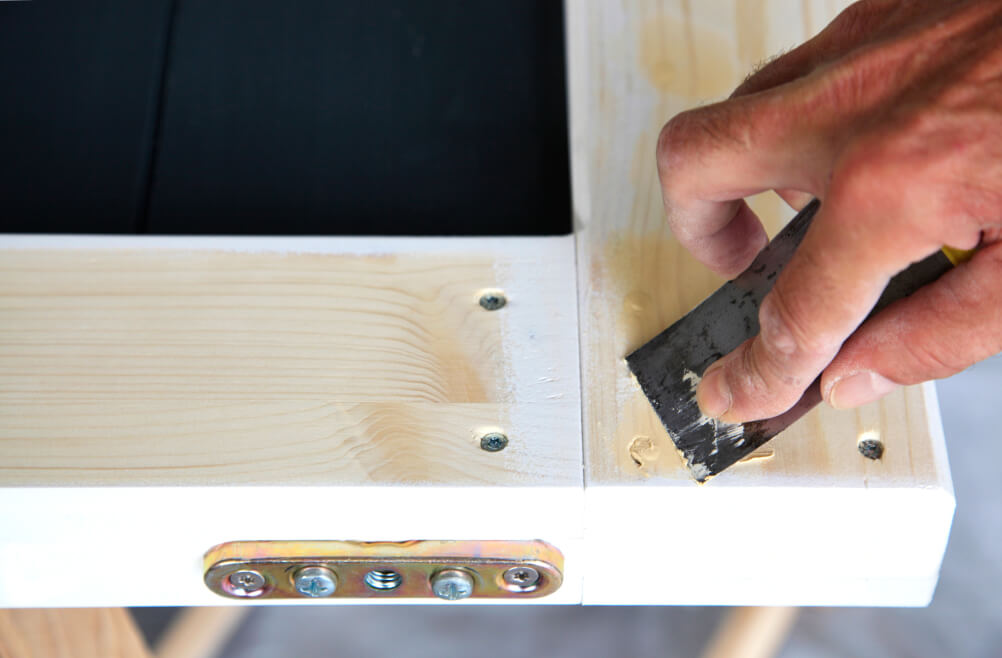
Vinyl wood filler is one of the most commonly used fillers on the market. It typically comes pre-mixed and comes in loads of colour variations to match the wood or blend in nicely under the paint. As these are pre-mixed, they often have a long drying time but do offer a good finish if you can match the filler to the wood.
Epoxy fillers come in two parts; the filler itself and then a catalyst. Once you add the catalyst to the filler, you have a short working time, and then the filler will set extremely quickly.
Again, these fillers come in various colours to match wood and can be stained with wood stain prior to adding the catalyst. Epoxy fillers are fantastic for filling voids as they don’t shrink over time, and they are as flexible as wood.
Once dried, they can be sanded for a smooth finish, painted, and even look great underwood oils and varnishes too. For us, Epoxy wood fillers are the most versatile filler on the market.
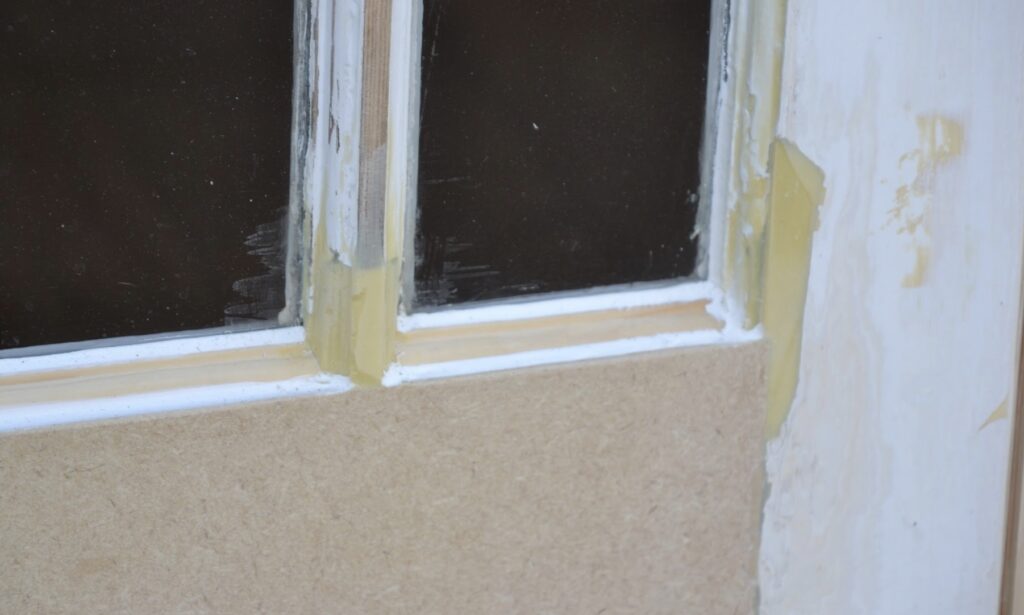
Gypsum is the same material used in many wall plasters. As a result, gypsum-based fillers can be excellent when you need a breathable filler. It isn’t as flexible as some other fillers, though. So, if a room sees a lot of temperature changes throughout the year and the wood moves a lot as a result, an epoxy filler may be better for you. Still, gypsum-based fillers can be used to fill cracks, holes and more in a lot of different materials.
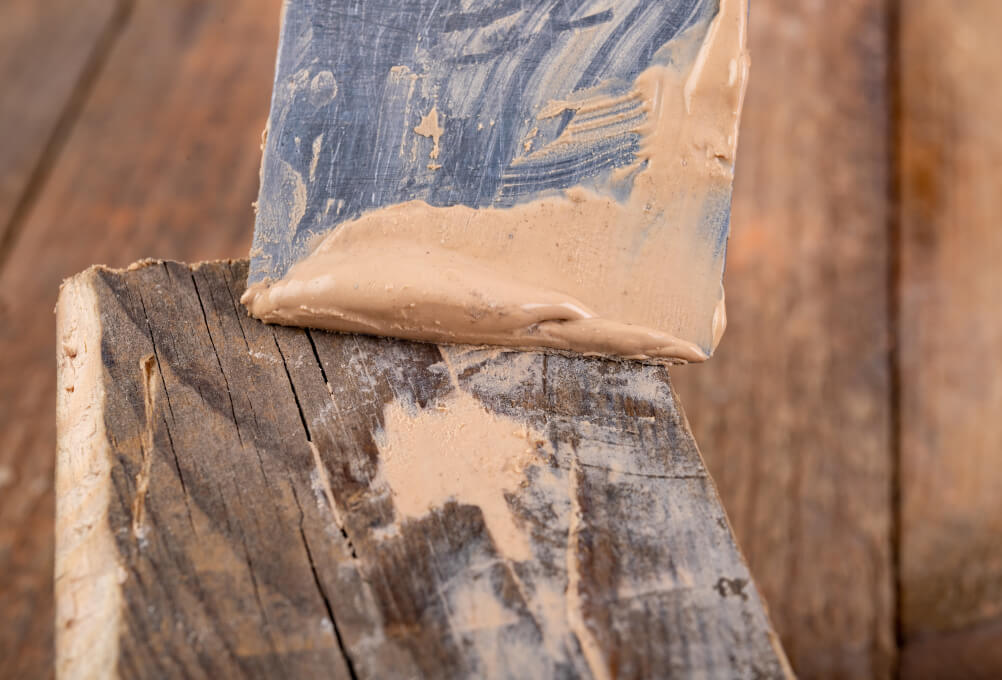
Cellulose filters are incredibly strong because they have real wood fibres in them. It is basically like filling a crack in wood with MDF. They usually come as a dry paste that you mix. The binders in this filler dry it very quickly, so while you don’t get much working time, you can sand it, drill it and paint it very quickly after applying.
Latex filler is a water-based wood filler that doesn’t crack or shrink over time but can during the first few hours of application. After the water in the filler has evaporated, the filler can shrink and crack, which means you’ll have to add more. If you are prepared for this, latex is a good option. It is really flexible and can be dyed, painted, sanded, drilled and more.
When it comes to choosing the best filler for exterior wood, several factors come into play. Exterior wood fillers need to withstand the elements, including fluctuating temperatures, humidity, and exposure to rain and sunlight. The filler you choose must be robust, durable, and flexible enough to move with the wood as it expands and contracts. Here’s a detailed look at some of the top contenders for the best exterior wood fillers:
Epoxy wood fillers are often the go-to choice for exterior wood restoration. They are renowned for their durability and resistance to environmental conditions. Epoxy fillers, such as the Repair Care Dry Flex, are two-part systems consisting of a resin and a hardener. Once mixed, they offer a short working time but cure to form a rock-hard finish. These fillers do not shrink or crack over time, making them ideal for long-lasting repairs. Additionally, they can be sanded, drilled, and painted, providing a seamless finish that blends perfectly with the surrounding wood.
Vinyl wood fillers are another excellent option for exterior woodwork. These fillers come pre-mixed and are available in various colours to match different types of wood. Although they tend to have a longer drying time compared to epoxy fillers, they offer a good finish if applied correctly. Vinyl fillers are flexible and can withstand moderate exposure to the elements. They are best used for filling small to medium-sized gaps and holes in wood.
Cellulose-based fillers contain real wood fibres, providing a natural look and feel once applied. These fillers are very strong and dry quickly, making them suitable for exterior repairs. They are typically mixed with water before application and can be sanded, drilled, and painted once dried. Cellulose fillers are ideal for filling larger gaps and cracks in exterior wood, as they bond well and provide a sturdy, long-lasting repair.
Ultimately, the best exterior wood filler for your project will depend on the specific needs and conditions of the wood you are repairing. For high-durability and resilience, epoxy fillers like Repair Care Dry Flex are unmatched. If flexibility and ease of use are more important, vinyl or latex fillers may be more suitable. For a natural wood finish, cellulose-based fillers are an excellent choice. Always consider the environmental exposure, the size of the repair, and the finish you desire when selecting a wood filler for exterior applications.
Now you know a bit about wood fillers, here are our top picks for the best wood fillers in the UK in 2024.
Dry Flex is our go-to filler. It can be used for all repairs, refurbishments and decorating tasks in wood. It is highly flexible, which makes it ideal for exterior applications that will move throughout the seasons. However, it is also highly durable and resilient. This means it can be sanded, drilled, cut and more.
We use this wood filler for a host of tasks. We fill in small areas of rot with this filler, and it strengthens the wood around it. We also use it to fill in old nail holes and a great deal more too. It is a two-part epoxy resin filler that can be stained after application, and it works brilliantly under the paint.

If you need a wood filler that is very, very tough and matches the colour of wood perfectly, this is a solid choice. This wood filler from Everbuild comes in a host of different colours to match a lot of common woods around the home, including oak, pine, mahogany and redwood.
This filler can also be stained to match the colour of any seasoned or raw wood and takes varnish very well. After just 30 minutes, you have a filler that can be sanded, drilled or varnished to create a nearly invisible wood repair. It is suitable for all temperatures within the UK and hard-wearing enough to be used on flooring and just about anywhere else in the home.
Rustins make some of the best and most high-quality wood stains, varnishes and fillers on the market. So, it’s no surprise its fantastic wood filler ended up on our list. This is also a two-part epoxy filler that dries in just 30 minutes. It is ideal for indoor and outdoor projects and comes in a natural colour that can be stained, varnished and a great deal more.
This is an ideal filler to use if you have different materials to repair. This can be used on wood, metal and concrete to repair many different cracks, voids and holes with a single tub of this filler. This filler is available in 1-kilo tubs, which sounds excessive for smaller projects. However, because it can be used on loads of different materials and has a very long shelf-life, you will use all of it.
For our money, the best wood filler on the market, without question, is Dry Flex from Repair Care International. It is the most hard-wearing epoxy filler we have ever used, and it is so easy to apply. a 400ml pack of this filler also goes a very long way. It spreads really thinly compared to other fillers, so you really don’t waste much of it during a project.
We realise Dry Flex is much more expensive than the other fillers on this list, but it is well worth the money. It is the most robust filler on the market and so easy to work with. Whether you need a filler for exterior or interior woodwork, this is the one we’d choose.
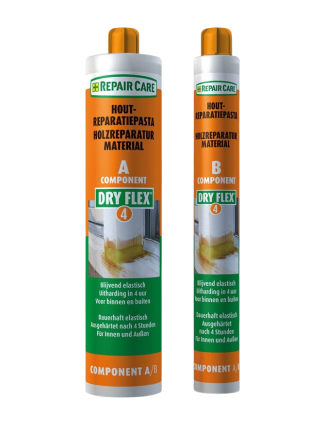
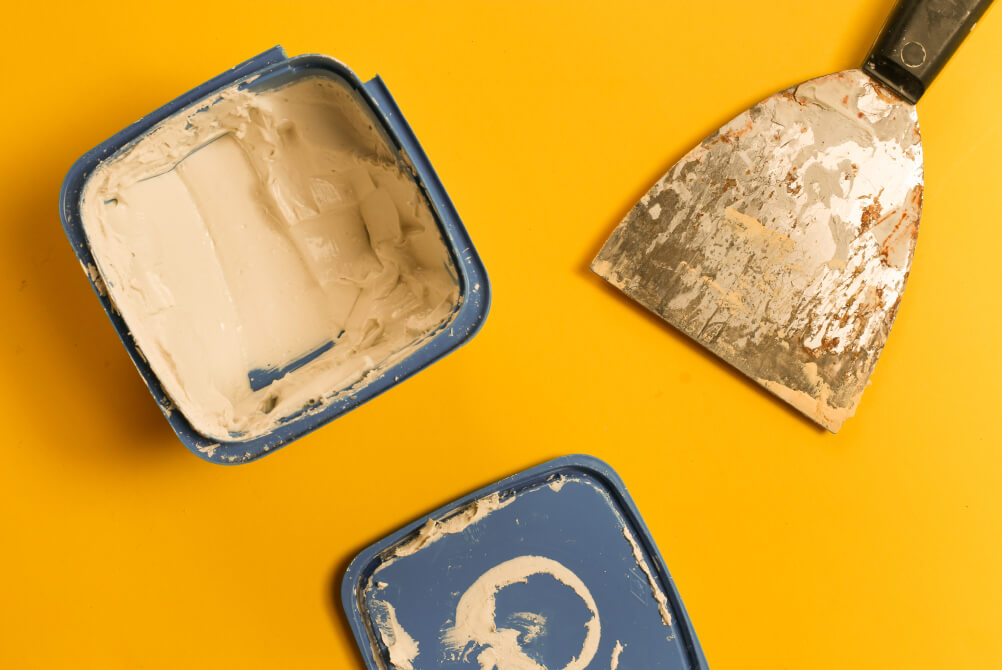
Choosing a wood filler isn’t as easy as walking into any shop and grabbing the first one you see. There are a lot of wood fillers available that are more trouble than they’re worth. So, here are some things to look for in wood filler that will help you get your project done right the first time.
Can the filler you intend to use be used on every material you need to repair? Can it take all of the finishes you need it to? Is it only for the interior, or is it an exterior wood filler too?
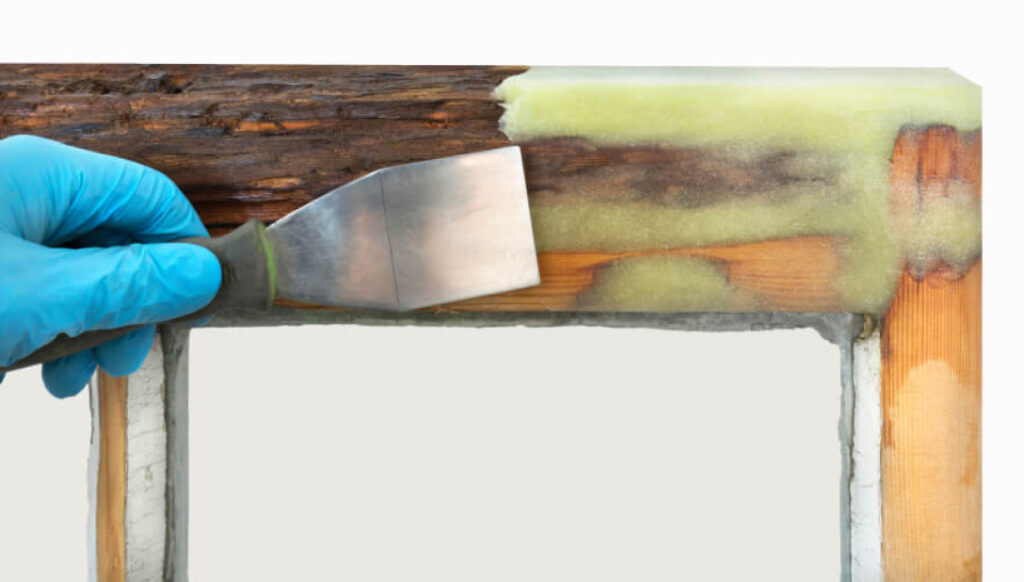
Some wood fillers can dry in 30 minutes and be painted right away; others take 24 hours to be ready to be sanded. Choose a drying time that suits your schedule.
It is always worth buying a wood filler that can be used for both interior and exterior wood. You may only need interior wood fixing right now, but what about in three months? Most wood fillers have a long shelf life, so you might as well use them!
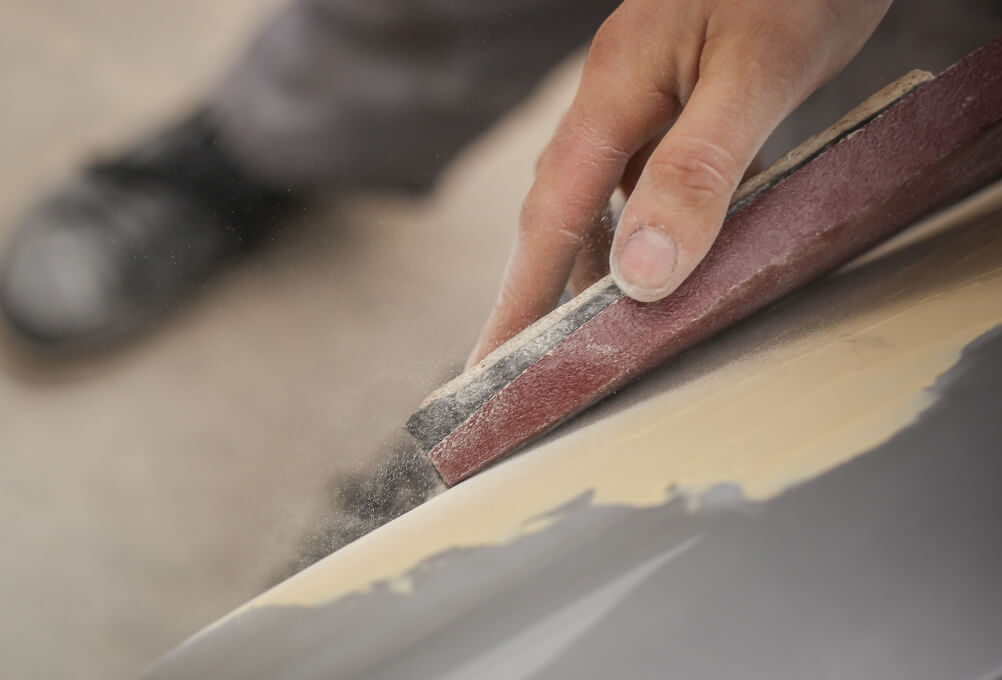
If you are buying a pre-mixed filler, don’t buy a massive amount unless you have a massive amount of filling to do. These dry out quite soon after you open them. If you are using a two-part epoxy filler, though, these have a much longer shelf life, so you can buy more than you need right now without wasting them.
Generally, wood fillers can be used on any wood surface, but ideally, they are best used for repairing holes and other damage on unfinished wood. While you can use fillers to fix damage on painted or stained surfaces, very glossy finishes might not accept the bond as well, leading to a cracked or uneven repair. Lightly sand the area surrounding the damaged spot to achieve better results.
Most wood fillers can be painted and stained, but fillers containing real wood fibres, such as our best paintable pick, Famowood Wood Filler, accept paint and stain better. For the most discreet results, ensure the filler you choose matches the wood tones of your project.
For exterior wood repairs, opt for fillers designed to withstand exposure to rain, moisture, and varying temperatures. Products like Gorilla High Performance Wood Filler are formulated for exterior use and resist moisture without becoming soggy. Solvent-based fillers offer superior weather resistance compared to water-based options, but water-based fillers can also be effective if covered with a waterproof sealer or paint once dry.
When it comes to choosing the strongest wood filler, epoxy-based fillers stand out as the top choice. Epoxy fillers are known for their exceptional durability, resistance to shrinkage, and ability to bond strongly with wood. These fillers consist of a two-part system that includes a resin and a hardener. When mixed, they create a compound that not only fills gaps and cracks but also reinforces the wood structure, making it incredibly robust.
Epoxy fillers are particularly useful for structural repairs where strength and longevity are crucial. They can be used for both interior and exterior applications and are highly resistant to environmental factors such as moisture and temperature changes. Additionally, once cured, epoxy fillers can be sanded, drilled, painted, and stained, offering great versatility for various woodworking projects.
According to Alex, an industry expert at The Chameleon Decorators,
“Epoxy wood fillers are unparalleled in terms of strength and durability. They not only fill and repair damaged wood but also reinforce it, ensuring a long-lasting solution. For any critical structural repairs, an epoxy-based filler is the best choice due to its superior bonding and resistance to environmental stressors.”
By choosing a high-quality epoxy wood filler, you can ensure that your wood repairs are not only strong and durable but also seamlessly blend with the existing woodwork.
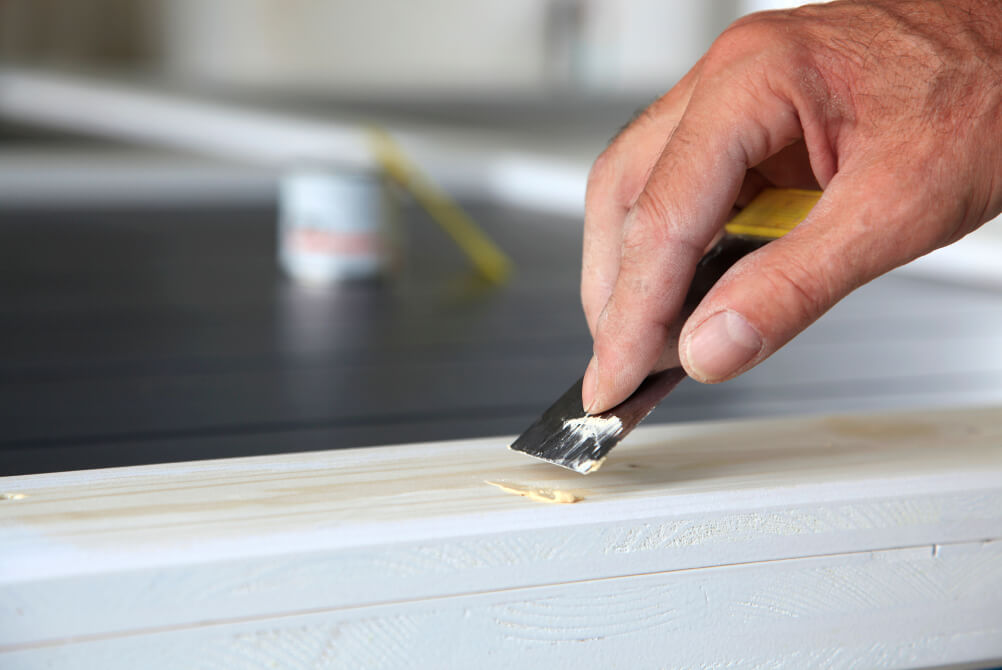
Wood putty is a solvent-based product that remains pliable after you have applied it. It is much denser than filler, so you need a putty knife to apply it.
Putty doesn’t shrink or crack because it is oil and plastic-based. However, because it remains so flexible after use, it cannot be sanded like wood filler.
Many wood fillers replicate the flexibility of putty but can also be sanded, so for most tasks, wood filler is the best option. So the only real difference between wood putty and wood filler is that putty can’t be sanded, drilled or cut once applied.
Using wood filler effectively ensures a seamless repair that blends well with the surrounding wood. Here’s a step-by-step guide to help you achieve professional results:
By following these steps, you can ensure that your wood repairs are durable and blend seamlessly with the existing woodwork.
We hope this look at wood fillers has helped you decide which one is right for your next project. As we said, we love the versatility and robustness of Dry Flex.
However, if you can’t justify the price of this filler, any two-part epoxy filler we mentioned above will be a solid choice. Why not explore Chameleon’s blog more for other helpful tips and products for DIY and woodworking projects?
The Chameleon Decorators has built a stellar reputation in the UK for providing top-notch restoration services, particularly in wooden window restoration. With years of hands-on experience and a portfolio that showcases a range of successful projects, our expertise is second to none.
Article is written in collaboration by Victoria, our esteemed customer support and content manager, who has extensive knowledge of window renovation, and Alex, an industry expert with a deep understanding of both modern and traditional restoration techniques Alex’s insights and detailed guides are featured on our site, and he is a recognised authority in the field, frequently sharing tips and best practices on social media.
We meticulously evaluate and use only the best materials, ensuring every project withstands the test of time and the elements. By considering customer feedback and continuously researching new methods and products, we ensure our recommendations are both practical and reliable. Our commitment to quality and customer satisfaction is reflected in the trust our clients place in us, making us a go-to source for restoration advice and services.
Yes, most wood fillers can be painted once dry.
For most DIY and woodworking projects, wood filler is the better option if you intend to sand, drill, paint or apply varnish to it.
We use two-part epoxy wood fillers like Dry flex. In our experience, two-part epoxy fillers work extremely well on all exterior and interior woodwork. They are quick to apply, don’t shrink and provide endless possibilities when it comes to staining and painting.
In many cases, wood filler is often stronger than the wood itself.
You can, but depending on the filler you use, you’ll likely have to fill deep holes in stages. All wood fillers state how thick they can be applied in the instructions.
The drying time of wood filler can vary depending on the type. Some wood fillers can dry within 30 minutes and be ready for sanding or painting right away. Others might take up to 24 hours to be fully cured and ready for further work. It’s important to check the specific drying time for the wood filler you are using to ensure your project timeline is accurate.
Wood fillers are made from various materials, depending on the type. Commonly used materials include vinyl, epoxy, gypsum, cellulose, and latex. Each type has its unique properties, with some containing real wood fibers (like cellulose-based fillers) and others using synthetic compounds for flexibility and durability (like epoxy fillers). The choice of material impacts the filler’s application, drying time, and how well it matches and adheres to the wood.